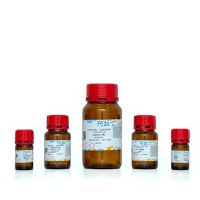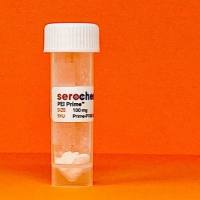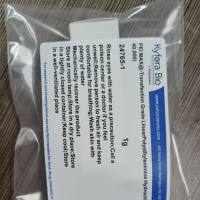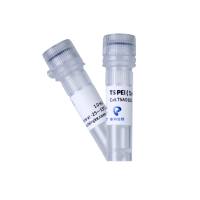|
ABSTRACT |
This protocol describes the preparation of polyethylenimine (PEI)/DNA nanoparticles for targeted gene delivery. This delivery strategy improves the efficiency of gene transfer by enhancing the entry of gene vectors into the desired cells and reducing uptake by nontarget cells. We describe here methods for the conjugation of targeting peptides to PEIs, formation of DNA complexes using the conjugated PEIs or nonconjugated PEIs together with targeting peptides, and cell transfection using these complexes. The conjugation step involves the use of the succinimidyl-4-(N-maleimidomethyl)cyclohexane-1-carboxylate (SMCC), a heterobifunctional cross-linker, to form a stable bond between PEI and peptides containing thiol groups.
|
MATERIALS
|
Reagents
|
-
Dc protein assay kit
-
DMEM cell culture medium with 10% fetal bovine serum (FBS)
-
DMEM (Dulbecco's Modified Eagle's Medium)
-
100 units/ml penicillin
-
100 µg/ml streptomycin
-
2 mM glutamine
-
10% fetal bovine serum (FBS)
-
Exponentially growing mammalian cells
-
Lithium chloride
-
Luciferase assay reagents
-
Dimethylsulfoxide (DMSO)
-
OptiMEM serum-free cell culture medium
-
PEI polymers (MW 600-1000 kDa, Fluka; MW 750 kDa, 25 kDa, 2 kDa, and 800 Da, Sigma-Aldrich; MW 1.2, 10, or 70 kDa, Polysciences)
-
Peptides, prepared using conventional solid-phase, chemical synthesis method
-
Phosphate buffered saline (PBS)
-
137 mM NaCl
-
2.7 mM KCl
-
10 mM Na2 HPO4
-
2 mM KH2 PO4
To prepare 1 liter of PBS(Phosphate-buffered Saline), dissolve 8 g of NaCl, 0.2 g of KCl, 1.44 g of Na2 HPO4 , and 0.24 g of KH2 PO4 in 800 ml of distilled H2O. Adjust the pH to 7.4 (or 7.2 if required) with HCl. Add H2O to 1 liter. Dispense the solution into aliquots and sterilize them by autoclaving for 20 minutes at 15 psi (1.05 kg/cm2 ) on liquid cycle or by filter sterilization. Store the buffer at room temperature. If necessary, PBS may be supplemented with 1 mM CaCl2 and 0.5 mM MgCl2 . Can be made as a 10x stock.
-
Plasmid DNA encoding the luciferase reporter gene
-
Reporter Lysis Buffer, 5X (Promega), dilute to 1X in PBS
-
Succinimidyl-4-(N-maleimidomethyl)cyclohexane-1-carboxylate (SMCC)
-
Water, ultrapure sterilized
|
Equipment
|
-
Dialysis membranes (molecular weight size exclusion specification for purification of side reaction and excess products)
-
Freeze dryer
-
Luminometer
-
Magnetic stirrer and magnetic rod
-
Reaction vessel
-
Tissue culture vessels
|
METHOD
|
Activation of PEI with a cross-linker
-
Prepare a SMCC stock solution of 50 mM in DMSO. SMCC is moisture sensitive. The stock solution should be prepared using high-quality anhydrous DMSO in a dry nitrogen atmosphere. When stored at 4°C, the SMCC solution remains stable for ~3 months. Steps 1-10 should be performed in a chemical fume hood following chemical safe handling procedures.
-
Prepare a 10 mg/ml stock solution of PEI in DMSO. Add 2-5 mg of lithium chloride to increase the solubility of PEI.
-
Using a syringe, slowly add the SMCC solution into the PEI solution. Incubate the reaction for 2 hours at room temperature. The amount of SMCC solution added should be based on the desired molar ratio between SMCC to PEI.
-
Purify the modified PEI by dialysis against ultrapure water for 2 days, changing the water at least five times a day.
-
Collect the solution in a dialysis tube and freeze dry the sample.
Conjugation of peptide to activated PEI
-
Prepare a peptide stock solution of 20-50 mM in PBS.
-
Prepare a 10 mg/ml stock solution of the activated PEI (Step 5) in PBS.
-
Slowly add the peptide solution to the activated PEI solution. Incubate the conjugation reaction for 24 hours at room temperature.
The amount of the peptide added to the reaction should be based on the desired molar ratio in the final conjugate.
-
Purify the peptide-conjugated PEI by dialysis against ultrapure water for 2 days, changing the water at least five times a day.
-
Collect the solution into a dialysis tube and freeze dry the sample.
Preparation of PEI/DNA complexes
-
Prepare the stock solutions.
-
Prepare a 1 mg/ml plasmid DNA stock solution in ultrapure water.
-
Prepare a stock solution of PEI (Step 5) or peptide-conjugated PEI (Step 10) to contain 10 nmol amino nitrogen per microliter in ultrapure water (pH 7.2).
-
For ternary complexes, prepare a 5-mg/ml stock solution of a targeting peptide linked with a DNA-binding sequence in ultrapure water.
Steps 11-22 should be performed under aseptic conditions using sterile reagents. Manipulation of the complexes should be performed at room temperature in a horizontal flow hood.
-
Prepare the working solutions.
-
Dilute 1 µg of plasmid DNA (for transfection of cells seeded in a well of a 24-well plate) in 50 µl of OptiMEM serum-free cell culture medium.
-
Dilute the appropriate quantity of PEI or peptide-conjugated PEI in 50 µl of OptiMEM serum-free cell culture medium.
-
For ternary complexes, dilute the appropriate quantity of the targeting peptide in 50 µl of OptiMEM serum-free cell culture medium.
-
Add the peptide-conjugated PEI solution dropwise into the DNA solution while vortexing. Or, for ternary complexes, add the targeting peptide dropwise into the DNA solution while vortexing.
-
Incubate the mixture for 30 minutes at room temperature. The peptide-conjugated PEI/DNA complexes may now be used directly for transfection (Step 16)
-
To form ternary complexes, add the PEI solution dropwise into the targeting peptide/DNA complexes while vortexing. Incubate the ternary complexes for 30 minutes at room temperature.
The ternary complexes may now be used directly for transfection (Step 16)
Transfection assay
-
One day before transfection, harvest mammalian cells, grown in DMEM complete cell culture medium with 10% FBS by trypsinization, and replate them into 24-well plates at a density of 50,000 cells/well. Incubate the cultures for 24 hours at 37°C in a humidified incubator with 5% CO2 .
-
Remove the medium from the wells and wash the cells twice with PBS (prewarmed to 37°C).
-
Add the following to the cells, and incubate them for 4 hours at 37°C in a humidified incubator with 5% CO2 . 100-150 µl/well of OptiMEM serum-free cell culture medium 100-150 µl/well of the gene transfection complex containing 1 µg of plasmid DNA (Step 14 or Step 15)
-
Remove the transfection solution, wash the cells twice with PBS (prewarmed to 37°C) and add 1 ml/well of DMEM complete cell culture medium with 10% FBS. Incubate the cells for 24-48 hours.
-
To assay for luciferase expression, lyse the cells by adding 100 µl/well of 1X Reporter Lysis Buffer (dilute 5X stock solution with PBS).
-
To detect luciferase activity, add 20 µl of cell lysate to 100 µl of luciferase assay reagent. Measure luciferase activity with a luminometer.
-
To normalize the luciferase activity, determine the protein concentrations of the cell lysates using the Dc protein assay kit.
|
|
ACKNOWLEDGMENTS |
The work was funded by the Institute of Bioengineering and Nanotechnology, the Agency for Science, Technology and Research (undefined STAR) in Singapore.
|
Anyone using the procedures in this protocol does so at their own risk. Cold Spring Harbor Laboratory makes no representations or warranties with respect to the material set forth in this protocol and has no liability in connection with the use of these materials. Materials used in this protocol may be considered hazardous and should be used with caution. For a full listing of cautions regarding these material, please consult:
Gene Transfer: Delivery and Expression of DNA and RNA, A Laboratory Manual , edited by Theodore Friedmann and John Rossi, © 2007 by Cold Spring Harbor Laboratory Press, Cold Spring Harbor, New York, p. 473-478 |







